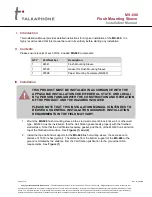
13
stripes. The data and parity information is arranged on the drive array so that parity is written to all drives. There are at
least 3 members to a virtual R5 volume. The following example illustrates how the parity is rotated from drive to drive.
The R5 MODE uses less capacity for protection and is the preferred method to reduce the cost per megabyte for larger
installations.
In exchange for low overhead necessary to implement protection, the R5 MODE degrades performance for all write
operations. The parity calculations for R5 MODE may result in write performance that is somewhat slower than the write
performance to a single drive.
The resulting storage capacity of the virtual R5 volume will be four times of the smallest drive.
If one drive fails, the virtual R5 volume is still usable, but it is in a vulnerable state because its mirrored hard drive is
inaccessible. When the offline drive comes back online, the appliance begins a rebuild process immediately to restore data
redundancy. A message appears in the LED indicator to notify you that a rebuild is in progress.
Although the volume remains available during the rebuild process, the volume is susceptible to data loss through damage to
the remaining drive until redundancy is restored at the end of the rebuild and verification process. Host access takes
precedence over the rebuild process. If you continue to use the virtual R5 volume during the rebuild, the rebuild process
will take a longer time to complete, and the host data transfer performance will also be affected.
ER104UT(-B)














































